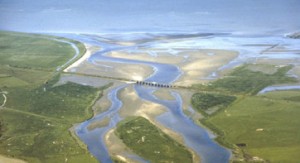
The River Roe is an extremely important river for Atlantic Salmon with 8% of the Northern Ireland spawning population and making the river and its tributaries one of the most important salmon rivers in the British Isles.
The River Roe and its tributaries are among the most productive rivers within the Foyle area. It also has a considerable run of migratory sea trout.
The fish community reflects the extent and diversity of the river system. As well as salmonids, which include brown trout and Atlantic salmon, the fast-flowing waters support stone loach, minnow, eel and 3-spined stickleback. Sea Lamprey are also known to migrate into the lower reaches of the River Roe.
Along with its importance for fish species the River Roe has many bird species associated with it, such as dippers which are rounded, with a short-tailed, a striking feature is the large white bib against otherwise dark plumage. Dippers are unique in the songbirds, for their ability to wade, swim and dive in running water. They exclusively inhabit the waters edge, and are found along fast-flowing rivers, look for tell-tale droppings on stones in the river.
And Kingfishers which are found along clean waterways and build there nests in tunnels along the riverbank. They are currently under threat from pollution and inappropriate development of our water ways.
Listen out for their flutey whistle as you walk along the river – you often hear them just before you see the flash of electric blue.
Otters are also found along the River Roe. They live along rivers, loughs and the coast feeding on fish, shellfish, smaller mammals and birds.
They are shy, solitary animals and are active mainly at night, although if you are very lucky you may see one during the day.
They need clean unpolluted water with a good supply of food and as such, can be used as indicators of high water quality.
You can walk along the River Roe on the outskirts of Limavady.


